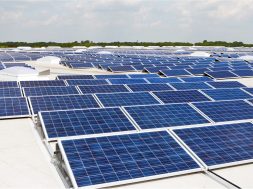Reliance targets 20GW solar PV manufacturing by FY25

Reliance Industries is introducing a major solar PV factory this fiscal year, with a goal of 20GW capacity and net-zero emissions by 2035.
Reliance Industries Ltd, India’s most valuable corporation, intends to commission its first solar the giant factory this fiscal year as it embarks on a green journey to attain net zero carbon emissions from operations by 2035. In its greatest annual report, the company stated that it intends to commission the first train of 20GW solar PV (photovoltaic) manufacture by the end of the fiscal year 2024-25 (April 2024 to March 2025), then proceed to a phased increase to 20GW by 2026.
The solar mega factory will manufacture PV modules, cells, wafers and ingots, polysilicon, and glass in a single place. The modules convert sunlight to power. It also intends to industrialise sodium-ion cell production at the MW level by 2025, in addition to to pilot 50 MWh of lithium battery cells per year in 2026.
In 2021, Reliance declared plans to invest USD 10 billion over three years to build a new fuels company based on 100 GW of renewable power generation by 2030. The goal is to build four giga factories in Jamnagar, Gujarat, to manufacture renewable energy equipment, battery storage, fuel cells, and hydrogen.
“We have made significant progress in establishing factories that will be part of our integrated solar PV manufacturing,” the company states in its annual report. “New Energy will be commissioning its first train of Module and Cell Manufacturing in FY25.” Solar panels built in Jamnagar got BIS certification. “Parallelly, work on renewable energy development has commenced and Reliance has been allotted land in Gujarat,” according to the statement. “We aim to become the largest renewable energy (RE) developer in India.”
Aside from commissioning the first train of modules and cells for 20GW of solar PV manufacturing, 2024-25 may see the industrialisation of sodium ion cell production at the MW level. Next year, the PV factory will be phased up to 20GW, and a battery giga factory will be built, beginning with a 50 MWh per year lithium battery cell pilot.
It intends to create a 50 GWh cell-to-pack manufacturing facility in FY27, with a goal of establishing 100 GW renewable energy capacity by 2030. The 100GW aim is going to propel the corporation to the forefront of global renewables ambitions, alongside Enel, Iberdrola, TotalEnergies, and BP in terms of capacity increases.
Reliance states that fossil fuels have historically met India’s power needs. “Structural inefficiencies combined with rising costs of fossil fuel has resulted in expensive power for commercial and residential customers – average tariff of Rs 10 per kWh (unit).”
Consequently, is not feasible for India to continue relying on fossil fuels for economic growth, it says, adding that the usage of fossil fuel-based energy increases dependence on imports and results in an outflow of foreign cash.
“Stable and cost-effective green power is critical. “India needs to solve this problem to maintain its growth trajectory and reach USD 32 trillion GDP by 2047,” it stated. Reliance added that over the next 12 months, its priority is going to bring new energy manufacturing facilities online, operate them efficiently, and begin developing renewable energy producing projects.
“Simultaneously, we would develop the supply chain locally for self-sufficiency and reduce the reliance on imports,” according to the report. The firm’s goal is to collaborate with leading global climate technology and product firms to establish a business model that is flexible and adaptive to new technologies, and is also future-proofed to be the lowest life cycle cost and best in class.
Reliance is establishing several sustainable energy collaborations, including solar and electric mobility, while continuing to pursue its oil and petrochemical goals. Jamnagar, the world’s largest single-site integrated refinery complex, consists of two refineries, one for local use and one for exports, which can process low-grade oil and switch between fuels based on price.
For more details , visit : https://www.ril.com/businesses/new-energy-materials
Cookie Consent
We use cookies to personalize your experience. By continuing to visit this website you agree to our Terms & Conditions, Privacy Policy and Cookie Policy.






